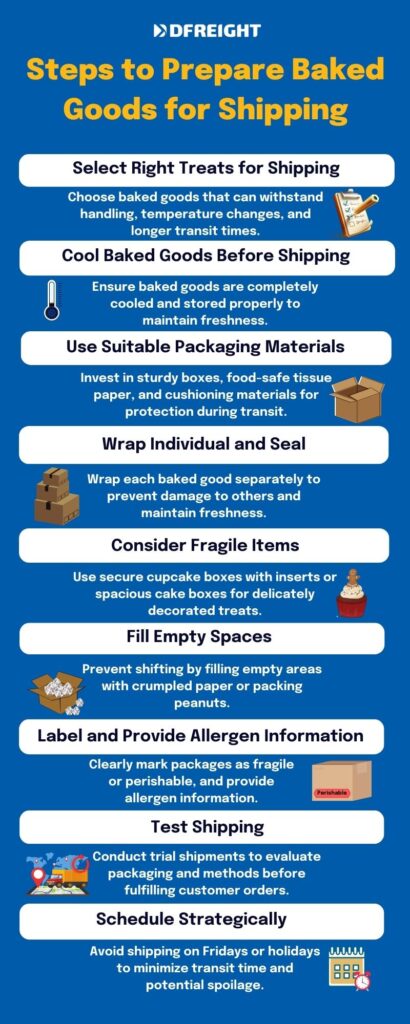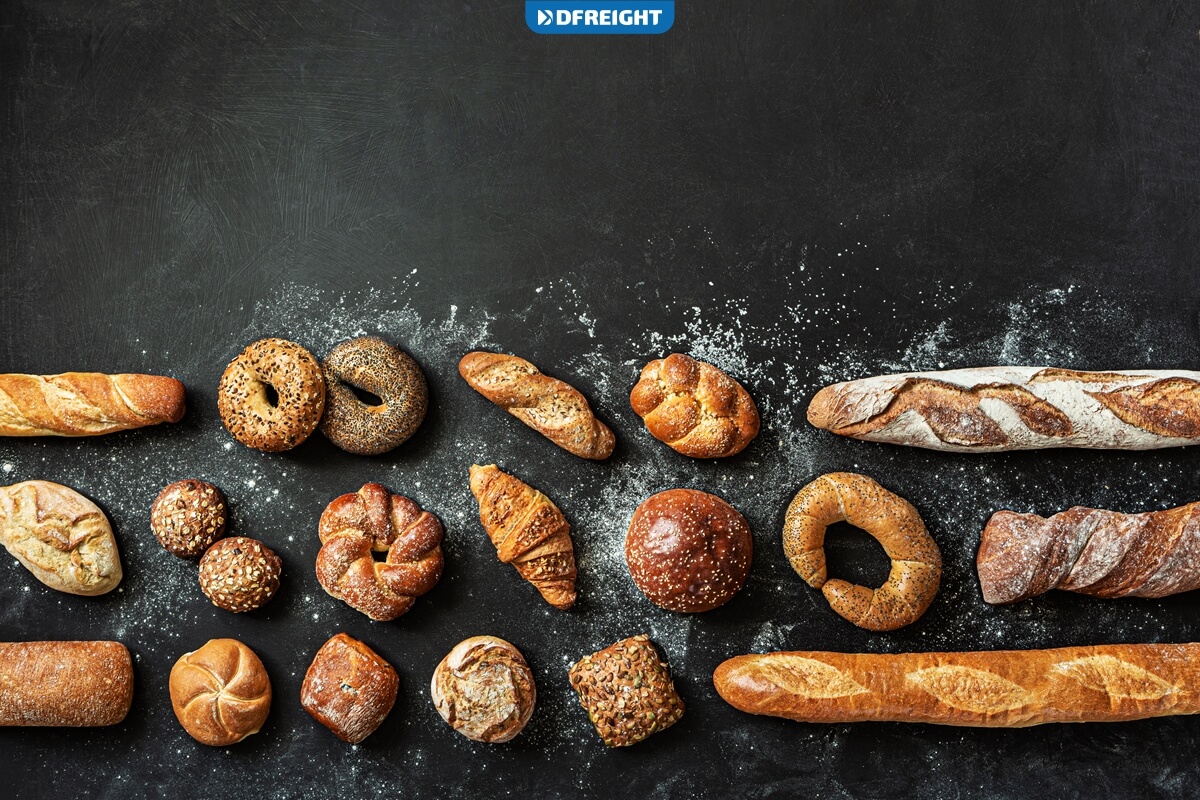Welcome to the world of shipping baked goods! Whether you’re a home baker passionate about creating delectable treats, Bakery and Confectionery owner, or a business owner sharing your delicious creations with the world, ensuring that your baked goods arrive safely and in perfect condition is essential. If you’ve ever sent or received baked goods, you know the disappointment of opening a package to find crushed cookies or a damaged cake. Whether you’re shipping locally or internationally, this guide is designed to equip you with the knowledge and tools to avoid such unfortunate scenarios and create a positive shipping experience for both sender and receiver.
Shipping perishables like baked food can be a delicate process, requiring a reliable and experienced freight forwarder to ensure freshness and timely delivery. DFreight is a digital freight forwarder with an innovative online platform and mobile app that provide seamless logistics management. Our extensive expertise in handling perishables gives you peace of mind, knowing that your baked goods are in capable hands. With our dedication to excellence and years of experience in the field, DFreight is the ideal partner for shipping perishables, allowing you to focus on delivering delicious treats to your customers without worry.
Table of Contents
Introduction
Baked goods delight the senses, but their delicate nature makes shipping them challenging. From mouthwatering cookies and delicate pastries to moist cakes and savory bread, each treat demands special care during transit to preserve its flavor, texture, and appearance. Proper packaging and shipping practices play a pivotal role in maintaining the quality of your baked goods, preventing breakage, and safeguarding against potential mishaps.
Understanding the Challenges
Shipping baked goods presents a unique challenge that requires careful consideration and planning. Unlike standard items, such as clothing or electronics, baked goods are delicate and perishable, and their quality can be easily compromised during transit. As a baker or seller, it’s crucial to grasp the intricacies of these challenges to ensure your treats reach their destination in the same delectable condition they left your kitchen.
- The Delicate Nature of Baked Goods: Baked goods are often created precisely, using specific ingredients and baking techniques to achieve the perfect taste and texture. They are susceptible to breakage, crushing, and temperature fluctuations during shipping, which can alter their appearance and flavor. Understanding the delicacy of your treats is the first step in devising an effective shipping strategy.
- Factors Affecting the Quality During Shipping: Various factors come into play regarding maintaining the quality of your baked goods during shipping. Temperature, humidity, handling procedures, and transit duration can all impact the final product. Even minor fluctuations in these factors can result in significant changes to the taste and texture of your treats.
- Common Pitfalls to Avoid: Without proper planning and attention to detail, you may encounter pitfalls that can negatively affect your shipping process. Some of these pitfalls include inadequate packaging materials, choosing the wrong shipping service, or not considering the destination’s climate and potential delays. Recognizing these potential stumbling blocks is vital to ensuring a successful shipping experience.
To overcome the challenges of shipping baked goods, it’s essential to take a proactive approach and implement practical solutions. Here are some steps you can take to address these challenges effectively:
- Careful Selection of Treats: Not all baked goods are suitable for shipping. Choose treats that can withstand the rigors of transit and maintain their freshness. For instance, sturdy cookies, bars, and certain types of cakes are often better suited for shipping than delicate pastries or cream-filled items.
- Proper Cooling and Storage: Ensuring your baked goods are fully cooled and stored appropriately before packaging is essential. Shipping warm or freshly baked items can lead to condensation inside the packaging, causing a loss of quality or spoilage.
- Optimal Packaging Materials: Invest in high-quality packaging materials that provide adequate protection during shipping. Customized packaging for specific treats, such as cookie tins, cake boxes, or padded liners, can significantly reduce the risk of damage.
- Temperature Control: For temperature-sensitive treats, consider using insulated packaging or gel packs to maintain a stable climate during transit. This is especially important for shipping to warmer regions or during hot weather conditions.
- Selecting Reputable Shipping Services: Research and choose reliable shipping carriers known for handling delicate items with care. Consider factors such as shipping speed, tracking options, and experience in handling perishable goods.
- Communication with Customers: Set clear expectations with your customers about shipping times, potential delays, and how you protect the quality of your treats during transit. This transparency builds trust and ensures they are aware of the care you put into delivering their orders.
By understanding the unique challenges of shipping baked goods and implementing thoughtful solutions, you can confidently share your delectable treats with customers near and far, spreading joy and satisfaction with every delivery.
Preparing Your Baked Goods for Shipping
Before you send out your delicious treats on their journey to delight taste buds, ensuring they are adequately prepared for the shipping process is crucial. Proper preparation preserves the quality and taste of your baked goods and reduces the risk of damage during transit. Follow these essential steps to prepare your treats for a safe and enjoyable shipping experience.

- Select Right Treats for Shipping: Not all baked goods are equally suitable for shipping. Choose treats that can withstand handling, temperature changes, and longer transit times without compromising their taste and appearance. Sturdy cookies, brownies, bars, and certain types of cakes typically fare well during shipping. Delicate pastries or cream-filled items may not hold up as effectively.
- Cool Baked Goods Before Shipping: Allow your baked goods to cool completely before packaging. Warm treats can create condensation inside the packaging, leading to a loss of quality or even mold growth. Once cooled, store them appropriately in airtight containers or packaging to maintain freshness.
- Use Suitable Packaging Materials: Invest in high-quality packaging materials and supplies that offer sufficient protection for your treats. Use sturdy boxes, food-safe tissue paper, bubble wrap, or packing peanuts to prevent shifting and cushion your baked goods during transit. Ensure that all packaging materials are clean and free from any contaminants.
- Wrap Individual and Seal: Whenever possible, individually wrap each baked good before placing them in the shipping container. This ensures that even if one treat is affected during transit, the others remain intact. Sealing each item also helps maintain freshness and prevents any spillage.
- Consider Fragile Items: If you’re shipping more delicate items like cupcakes with intricate decorations, consider using cupcake boxes with inserts to hold them securely in place. For frosted cakes, opt for sturdy cake boxes that provide enough space around the edges to prevent damage to the frosting.
- Fill Empty Spaces: Fill empty spaces inside the shipping box with fillers like crumpled paper or packing peanuts to prevent shifting during transit. This will help cushion your baked goods and protect them from potential damage.
- Label and Provide Allergen Information: Clearly label the package as “Fragile” or “Perishable” to alert shipping carriers and handlers to handle the package carefully. Additionally, provide clear allergen information if your treats contain common allergens like nuts, dairy, or gluten.
- Test Shipping: Before sending out a large batch of orders, conduct test shipments to various locations. This will help you assess how well your packaging and shipping methods hold up, allowing you to make any necessary adjustments before fulfilling customer orders.
- Schedule Strategically: Plan your shipping schedule strategically to minimize the time your baked goods spend in transit. Avoid shipping on Fridays or days before holidays, which could lead to extended delivery times and potential spoilage.
By diligently preparing your baked goods for shipping and employing suitable packaging materials and techniques, you can ensure that your treats arrive at their destination looking and tasting as delightful as they left your oven. Providing your customers with perfectly preserved goodies will earn their satisfaction and build trust in your brand, encouraging repeat business and positive word-of-mouth recommendations.
The Art of Packaging
Packaging is more than just a means of transporting goods from one place to another; it is an art form that combines creativity, practicality, and protection. When it comes to shipping baked goods, mastering the art of packaging is essential to ensure that your treats reach their destination in perfect condition, delighting recipients and leaving a lasting impression. Here are some critical aspects of the art of packaging:
- Choosing the Best Packaging for Each Treat: Different baked goods have unique requirements when it comes to packaging. Selecting the right type of packaging for each treat ensures they are held securely, preserving their shape and preventing damage during transit. From sturdy boxes for cakes to individual wrappers for cookies, tailoring the packaging to each item is crucial.
- Techniques to Prevent Damage During Transit: Packaging involves using various techniques to protect your baked goods from potential mishaps during shipping. Layering tissue paper between delicate pastries, securing cupcakes with inserts, and using bubble wrap for fragile decorations are just a few examples of how thoughtful packaging can safeguard your treats.
- Aesthetic Appeal: Packaging is not just about protection; it also contributes to the overall presentation of your baked goods. Thoughtfully designed packaging with your brand’s logo, elegant wrapping, or creative touches can enhance the excitement of receiving the treats and elevate the customer experience.

- Eco-Friendly Packaging Alternatives: As consumers become more environmentally conscious, incorporating eco-friendly packaging options is a valuable aspect of packaging. Using recyclable or biodegradable materials shows your commitment to sustainability, resonating with eco-conscious customers.
- Proper Labeling and Information: Packaging includes providing clear labeling and essential information on the package. Labeling items as “Fragile” or “Perishable” alerts handlers to treat the package carefully, and clear allergen information helps customers make informed choices.
- Efficiency in Space and Weight: Skillful packaging maximizes space utilization while keeping the weight of the package within reasonable limits. This ensures cost-effective shipping and reduces the risk of package mishandling due to excessive weight.
Mastering the art of packaging goes beyond functional aspects; it also involves infusing your brand’s identity into the packaging design and ensuring that every detail reflects the care and dedication you put into your baked goods. The artful presentation of your treats not only protects their quality during transit but also adds an extra touch of delight to the entire shipping experience, fostering customer satisfaction and loyalty.
Addressing Legal and Regulatory Aspects
When shipping baked goods, complying with legal and regulatory requirements is essential to ensure both the safety of your treats and the legal protection of your business. Navigating food safety laws and regulations and labeling and allergen information requirements is crucial to avoid potential fines or legal issues. Depending on your location and the destination of your shipments, you may also need to obtain specific licenses or permits for shipping baked goods. Staying informed about the latest regulations and maintaining meticulous records of your compliance efforts will protect your customers and build trust in your brand.
Addressing these legal and regulatory aspects demonstrates your commitment to responsible business practices, helping you create a positive reputation and ensuring the continued success of your baking venture.
Selecting Shipping Services
When shipping your baked goods, choosing the right shipping services is paramount. Research reputable carriers are known for handling delicate items carefully, providing reliable tracking options, and offering timely deliveries. Consider factors such as shipping speed, coverage areas, and cost efficiency. Whether you opt for local carriers or international shipping companies, ensuring your treats are in the hands of a dependable shipping service will guarantee a smooth and satisfying delivery experience for you and your customers.
Tips for International Shipping
Shipping baked goods internationally adds another layer of complexity to the process, but with careful planning and attention to detail, it can be a successful endeavor. Here are some valuable tips to ensure a smooth and secure international shipping experience for your delectable treats:
- Research Import Regulations: Different countries have varying import regulations and restrictions on food items. Research the specific import requirements of each destination country to ensure compliance with their laws. This includes checking for prohibited ingredients, labeling requirements, or special permits for shipping baked goods.
- Choose Fast and Reliable Shipping Services: Opt for reputable international shipping carriers known for their reliability and efficient delivery times. Expedited shipping options can reduce transit times, minimizing the risk of spoilage or damage during longer journeys.
- Temperature-Sensitive Packaging: Consider the climate of the destination country and the time of the year when shipping perishable treats. Insulated packaging or ice packs can help maintain optimal temperatures, especially when shipping to warmer regions.
- Customs Declaration and Documentation: Provide accurate and detailed customs declarations for each shipment. Clearly state the contents, their value, and any necessary product descriptions to facilitate smooth customs clearance.
- Proactive Communication with Customers: Inform international customers about delays due to customs inspections or international holidays that may affect shipping times. Transparent communication helps manage expectations and reduces the likelihood of customer concerns.
- Test International Shipping: Before committing to large-scale international shipping, conduct test shipments to various countries to assess the effectiveness of your packaging and shipping methods.
- Offer Tracking and Insurance: Provide customers with tracking information for their international orders so they can monitor their package’s progress. Consider offering shipping insurance for added protection against loss or damage during transit.
- Pack Securely and Efficiently: Use sturdy, secure packaging to protect your baked goods during the long journey. Ensure items are well cushioned and use individual wrapping or dividers to prevent contact between treats.
- Consider Shelf Life and Freshness: Factor in the shelf life of your baked goods when calculating shipping times. Choose treats with a longer shelf life for international shipping or inform customers of the recommended consumption timeline upon delivery.
- Address Cultural Differences: Be aware of cultural differences affecting your packaging or marketing. Consider translating critical information, and respect local customs and traditions when designing packaging materials.
By carefully addressing the unique challenges of international shipping, you can expand your market reach, sharing your delightful baked goods with customers worldwide. Embrace the opportunity to introduce your culinary creations to diverse audiences. With thorough preparation and attention to the tips above, you can provide a delectable experience that transcends borders and delights taste buds around the globe.
What to Do in Case of Shipping Issues
Despite careful preparation and choosing reliable shipping services, shipping issues can occasionally arise. It’s essential to have a clear plan in place to address these challenges promptly and efficiently. Here are the steps to take if you encounter shipping issues:
- Document the Issue: Start by documenting the problem in detail. Record the date of shipment, tracking numbers, and a description of the issue, such as damage, delays, or missing items. This information will be helpful when communicating with the shipping carrier or addressing customer inquiries.
- Contact the Shipping Carrier: If you’re a business, contact the shipping carrier’s customer service as soon as possible to report the issue. Be prepared to provide the relevant information and ask for their assistance resolving the problem. Most carriers have protocols to handle shipping-related issues and will work to resolve them promptly.
- Track the Package: Use the tracking information provided to monitor the shipment’s progress. In case of delays or discrepancies, stay in touch with the carrier for updates and request them to take appropriate actions to locate the package or expedite delivery.
- Customer Communication: If you ship to customers, maintain open and transparent communication. In case of delays, inform customers promptly, apologize for the inconvenience, and provide an estimated new delivery date. Assure them that you are actively working to resolve the issue.
- Utilize Shipping Insurance: If you purchased shipping insurance, contact the carrier to initiate a claim for any damages or lost items. The insurance should cover the value of the goods, ensuring that you are compensated appropriately.
- Offer Solutions: In case of severe shipping issues, consider offering alternative solutions to affected customers. This may include resending the order, issuing a refund, or providing a discount on future purchases as a goodwill gesture.
- Evaluate and Improve: After resolving the shipping issue, evaluate what went wrong and how it can be prevented. Consider adjustments to your packaging, shipping methods, or carrier selection to minimize the chances of similar problems occurring again.
- Learn from Customer Feedback: If customers experience shipping issues, encourage them to provide feedback. This feedback is valuable in identifying potential problems and understanding areas for improvement in your shipping process.
- Build Relationships with Carriers: Developing a good working relationship with your chosen shipping carriers can be beneficial in handling shipping issues more effectively. Building rapport can lead to better communication and prompt resolution of future problems.
Remember, shipping issues are not uncommon, and how you handle them can significantly impact customer satisfaction and the reputation of your business. By being proactive, responsive, and solution-oriented, you can turn shipping challenges into opportunities to showcase your commitment to excellent customer service and the safe delivery of your delectable baked goods.
Conclusion
Shipping baked goods requires a delicate balance of art and science. By mastering the art of packaging, addressing challenges, complying with regulations, and utilizing practical tips, you can ensure your delectable treats reach their destination in perfect condition, leaving a lasting impression on your customers. Embrace the joy of sharing your passion for baking with the world, and may your shipping adventures be filled with satisfied customers and sweet success.
Happy shipping and happy baking!
Can I ship all types of baked goods?
While many baked goods can be shipped successfully, not all treats are equally suitable for shipping. Sturdy cookies, brownies, and certain types of cakes typically fare well during transit. Delicate pastries or cream-filled items may not hold up as effectively. It’s essential to choose treats that can withstand handling, temperature changes, and longer transit times without compromising their taste and appearance.
How should I package baked goods for shipping?
Proper packaging is crucial to protect your treats during shipping. Use sturdy boxes, food-safe tissue paper, bubble wrap, or packing peanuts to prevent shifting and cushion your baked goods. Individual wrapping and sealing can help maintain freshness and prevent spillage. Consider the climate of the destination and use insulated packaging or ice packs for temperature-sensitive treats.
Are there any legal considerations when shipping baked goods?
Yes, shipping baked goods involves legal and regulatory aspects that need to be addressed. Research food safety laws, labeling requirements, and allergen information regulations in your area and the destination country. Additionally, you may need specific licenses or permits for shipping baked goods. Complying with these regulations ensures the safety of your treats and protects your business from potential fines or legal issues.
What should I do in case of shipping issues or delays?
Shipping issues may occasionally occur despite careful preparation. If you encounter problems, document the issue, and contact the shipping carrier’s customer service immediately. Provide customers with tracking information and communicate transparently about delays. Consider offering alternative solutions or refunds if necessary. Learn from customer feedback and evaluate your shipping process to prevent similar issues in the future.














